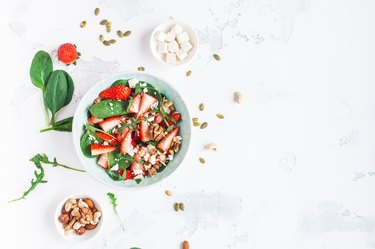
Wondering if you can eat tasty Greek yogurt, frozen yogurt and ice cream when you're on a low-carb diet such as Atkins or Keto? Going on a low-carb diet can greatly limit the type and amount of foods you can eat, but this doesn't necessarily mean that you'll need to give up yogurt and ice cream completely.
Keep reading to learn more about the carbohydrates in these dairy treats — and to find out whether or not you can work them into your eating plan without sacrificing your health and weight-loss goals.
Video of the Day
Video of the Day
The Skinny on Low-Carb Diets

Low-carbohydrate diets such as Keto, Paleo, Whole30, the South Beach Diet, the Zone Diet and that OG low-carb diet known as Atkins all call for reduced consumption of carbohydrates, especially sugar. But as the Iowa Clinic (IC) points out, each of these popular low-carb plans has different requirements when it comes to eating dairy foods such as yogurt and ice cream.
Lower-carbohydrate diets range from plans that ban all carbs to those that only limit certain kinds. "No two low-carb diets are the same," observes the IC. "Keto ... allows dairy, so cheese, plain yogurt, [ice] cream and butter are okay." But with Paleo and Whole30, dairy products are a no-no.
Atkins, on the other hand, is a phased plan that allows dairy (including cheese, butter, Greek yogurt and ice cream) in some phases, but not others. "The Atkins Diet holds that eating too many carbs — especially sugar, white flour and other refined carbs — leads to many issues," explains the Mayo Clinic. "The Atkins Diet says that [eating too many carbs] leads to blood sugar imbalances, weight gain and heart problems. To that end, the Atkins Diet limits carbs."
The amount of carbs you're allowed to consume each day depends on which low-carb diet plan you're following. "A daily limit of 0.7 to 2 ounces (20 to 57 grams) of carbohydrates is typical with a low-carb diet," says Mayo. "These amounts of carbohydrates provide 80 to 240 calories. Some low-carb diets greatly limit carbs during the early phase of the diet. Then those diets allow more carbs over time."
It's important to note that when it comes to yogurt and ice cream, carbs aren't the only issue: Fat content also matters. Some diets, like Atkins, allow unlimited fat consumption; others, including the Zone and South Beach Diet, limit it. If you're on the Zone or South Beach Diet, therefore, low-fat dairy products are acceptable, but full-fat, low-carbohydrate products are not. The opposite is true with Atkins.
Put simply, the carbohydrate and fat content of yogurt and ice cream can vary wildly, depending on the type of product — and sometimes even the flavor. So no matter which low-carb diet plan you choose, it's wise to read the nutrition facts on yogurt and ice cream containers before purchase, to verify that the fat and carbohydrate content fit your health goals.
Eating Dairy on a Low-Carb Diet
Depending upon which low-carb diet you choose to follow, you might be encouraged to focus on eating healthy fats. Dairy products are typically included in reduced-carbohydrate eating plans like these. However, which specific dairy products get the green light varies by plan.
Ice Cream

Diet-friendly ice creams range from low-fat and low-calorie ice cream treats to those with all the fat and none of the sugar (read: carbs). You'll fare better on your low-carb diet if you stick to plain, vanilla and fruit-flavored ice cream that is labeled "fat-free," "nonfat" or "low-fat" — especially varieties that contain no added sugar. That said, low-fat ice cream is often high in carbohydrates, even if the calorie count is reasonable. Case in point: Per the U.S. Department of Agriculture (USDA), a half cup of fat-free vanilla ice cream contains over 20 grams of carbs.
"If you're looking to cut back on sugar, you can try high-protein, low-sugar [ice cream] brands," suggests the University of Washington. "Ice cream already has some protein in it, but topping your treat with chopped nuts will give you a boost of protein and fiber, which will make you feel fuller faster."
If you're going low-carb, you'll also need to steer clear from carbohydrate-rich ice-cream accompaniments such as cones, sprinkles and sweet add-ins like cookie dough, chocolate chips and crushed candy bars. Delicious as they are, those sugary extras will kick your carb load into overdrive, and may have unwanted effects on both your weight and your blood sugar levels.
Yogurt

Yogurt is an excellent source of calcium and protein, providing an easy solution for meals or snacks on a low-carb diet. If you're reducing your carb count, skip sugar-sweetened yogurts and cut carbohydrates further by opting for plain, low-fat Greek yogurt. According to the USDA, it contains less than 8 grams of carbs per 7-ounce serving.
You can also try sugar-free, non-dairy yogurt alternatives, as long as their fat content doesn't break your diet's rules. "Stemming from the rise in popularity of plant-based non-dairy milks, yogurts made from soy, coconut, nuts, rice, and other plant foods have become more common on supermarket shelves," says the Harvard T.H. Chan School of Public Health. "Plant-based yogurts may be lower in protein, calcium and other nutrients unless they are fortified, so check the Nutrition Facts label if these nutrients are important in your diet."
It seems counterintuitive, but depending on your low-carb plan, you may want to choose whole-milk yogurts over low-fat or fat-free versions. Plain whole-milk yogurt has 8 grams of carbs per 6-ounce serving, per the USDA, while plain low-fat and nonfat yogurt contain 12 grams of carbs for the same serving size. That's because the fat in the latter is often replaced with sugar, to help make up for the flavor that is lost when the fat is removed.
Similarly, when companies add flavors to yogurt, they also increase the sugar — and thus the carb content. One cup of flavored frozen yogurt has almost 38 grams of carbs. Even vanilla-flavored low-fat yogurt has lots of carbs: almost 24 grams per 6-ounce container. A single serving of any of these these yogurt options exceeds the number of carbs you're allowed per day on most low-carb diet plans.
Because of the way that Greek yogurt is produced, it has higher amounts of protein and lower amounts of carbohydrates than regular yogurt. "Going Greek is a smart choice for low-carb dieters," affirmed the U.S. News and World Report in July 2023. "It contains roughly half the carbs as regular yogurt — 5 to 8 grams per serving compared with 13 to 17."
Much of the carbohydrate content of regular yogurt is found in the whey, which is drained to make the thicker Greek yogurt. This means that Greek yogurt is easier to fit into a low-carb diet, and you can choose one of the lower-fat options to help control your overall fat intake while still limiting your carb intake.
You can make plain yogurt of any type tastier while still limiting the number of carbohydrates it contains by flavoring it yourself with a small amount of chopped nuts or lower-carb fruits such as strawberries, blackberries, raspberries or apple. With these yummy additions, your yogurt will still contain fewer carbs than pre-flavored varieties — and it will be more nutritious, too.
A Word on Sweeteners

Many low-carbohydrate yogurts and ice creams are sweetened with artificial sweeteners or sugar alcohols like maltitol, as explained by the International Journal of Environmental Research and Public Health in July 2020. Artificial sweeteners have no calories, and are generally regarded as safe by the USDA. Sugar alcohols do contain calories, but are free of carbohydrates.
While some low-carbohydrate diets embrace these sugar alternatives, others recommended avoiding them. These sweeteners are typically found in full-fat and -calorie dairy products, and are therefore not appropriate for low-carb plans such as the South Beach or Zone Diet. Again, read product labels to make sure your dairy treat follows your chosen eating plan.
Warning
Low-carb diets are generally considered safe, "but you still need about 130 grams of carbohydrates for your brain and nervous system to work their best," warned the Cleveland Clinic in October 2022. "You may experience fatigue or other side effects if you don’t get enough carbs." If you experience headaches, constipation, trouble sleeping, nausea, bad breath or dizziness when following a low-carb diet, consult your doctor or nutritionist. They may recommend that you increase your intake of carbs a bit to see if your symptoms improve.
- Mayo Clinic: "Atkins Diet: What's Behind the Claims??
- The Iowa Clinic: "The Most Popular Low-Carb Diets, Compared"
- Mayo Clinic: "Low-Carb Diet: Can It Help You Lose Weight?"
- University of Washington Medicine: "Are the New Studies on Ice Cream Health Benefits True?"
- U.S. Department of Agriculture: "Ice Creams, Vanilla, Fat Free"
- U.S. Department of Agriculture: "Yogurt, Greek, Plain, Lowfat"
- Harvard T.H. Chan School of Public Health: "Yogurt"
- U.S. Department of Agriculture: "Yogurt, Plain, Whole Milk"
- U.S. Department of Agriculture: "Yogurt, Plain, Low Fat"
- U.S. Department of Agriculture: "Frozen Yogurts, Flavors Other Than Chocolate"
- U.S. Department of Agriculture: "Yogurt, Vanilla, Low Fat"
- U.S. News and World Report: "Is Greek Yogurt or Regular Yogurt Healthier for You?"
- International Journal of Environmental Research and Public Health: "Maltitol: Analytical Determination Methods, Applications in the Food Industry, Metabolism and Health Impacts"
- Cleveland Clinic: "How Many Carbs Do You Need To Lose Weight?"




